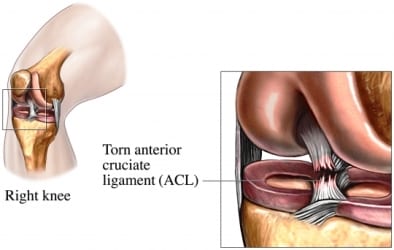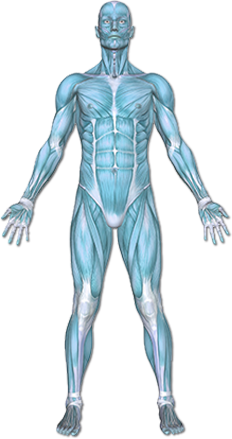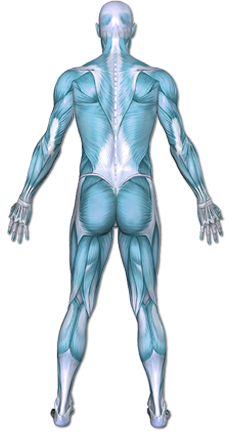ACL Tear
An anterior cruciate ligament (ACL) injury is a tear in the ACL ligament. The ACL is located in the middle of the knee joint. It connects the lower leg bone to the thigh bone. It stabilizes the knee and prevents the lower leg bone from sliding too far forward at the knee.


Copyright © Nucleus Medical Media, Inc.
This content was created using EBSCO’s Health Library
ACL injury occurs when your knee gets twisted or during a hard landing from a jump. It can also happen with:
- Sudden stops or changes in direction
- Sidestepping or pivoting
- Direct contact
This content was created using EBSCO’s Health Library
ACL injuries are more common in women. Other factors that increase your chance of ACL injury include:
- Weak knee structure
- Muscle strength imbalance between the quadriceps and hamstrings
- Playing sports that require sudden changes of direction and deceleration
- Use of incorrect technique for cutting, planting, pivoting, or jumping
- Previous injury or reconstructive ACL surgery
This content was created using EBSCO’s Health Library
Symptoms may include:
- A popping sound at the time of the injury
- Pain and swelling in the knee
- Loss of full range of motion
- Weakness or instability in the knee
- Difficulty walking
This content was created using EBSCO’s Health Library
You will be asked about your symptoms and how you injured the knee. A physical exam will be done. Your knee will need to be viewed. This can be done with:
- X-ray
- MRI scan
- Arthroscopy
Ligament sprains are graded according to their severity:
- Grade 1—Mild ligament damage
- Grade 2—Partial tearing of the ligament
- Grade 3—Complete tearing of the ligament
This content was created using EBSCO’s Health Library
Talk with your doctor about the best treatment plan for you. Recovery time ranges depending on the grade of the injury. Physical Therapy treatment may include:
- Exercises to help promote recovery. Specifically, therapists will design a program to strengthen the whole leg as well improve its range of motion.
- Balance exercises to allow you to return to your daily activities (including work and sports) while decreasing your risk of falling and reinjuring yourself
- Hands-on treatment to keep your knee joint from becoming stiff
- Ice and vasopneumatic pressure to reduce any swelling and pain
This content was created using EBSCO’s Health Library
To reduce your chance of injuring the ACL, take these steps:
- Plyometrics, a form of jumping exercises, can be used to train and strengthen the leg muscles for jumping and landing.
- When jumping and landing or turning and pivoting, your hips and knees should be bent, not straight.
- Strengthen both the quadriceps and the hamstrings.
- Maintain proper technique when exercising or playing sports.
This content was created using EBSCO’s Health Library
This content was created using EBSCO’s Health Library
RESOURCES:
- American Academy of Orthopaedic Surgeons
http://orthoinfo.org
- American Orthopaedic Society for Sports Medicine
http://www.sportsmed.org
CANADIAN RESOURCES:
- Canadian Orthopaedic Association
http://www.coa-aco.org
- Canadian Orthopaedic Foundation
http://www.canorth.org
REFERENCES:
- Anterior cruciate ligament (ACL) injury. EBSCO DynaMed website. Available at: http://www.ebscohost.com/dynamed Updated February 13, 2014. Accessed February 28, 2014.
- Anterior cruciate ligament injuries. American Academy of Orthopaedic Surgeons Ortho Info website. Available at: http://orthoinfo.aaos.org/topic.cfm?topic=A00549 Updated March 2009. Accessed February 28, 2014.
- Anterior cruciate ligament injuries: treatment and rehabilitation. Encyclopedia of Sports Medicine and Science website. Available at: http://sportsci.org/encyc/aclinj/aclinj.html Updated April 18, 1998. Accessed February 28, 2014.
- ACL Injury: Does It Require Surgery? American Academy of Orthopaedic Surgeons website. Available at: http://orthoinfo.aaos.org/topic.cfm?topic=A00297 Updated September 2009. Accessed February 28, 2014.
- Griffin LY, Agel J, et al. Noncontact anterior cruciate ligament injuries: risk factors and prevention strategies. J Am Acad Orthop Surg. 2000;8:141-150.
- Knee sprains and meniscal injuries. Merck Manual for Health Care Professionals. Available at: http://www.merckmanuals.com/professional/injuries_poisoning/fractures_dislocations_and_sprains/knee_sprains_and_meniscal_injuries.html Updated August 2013. Accessed February 28, 2014.
- Ligament injuries to the knee. John Hopkins Medicine website. Available at. http://www.hopkinsmedicine.org/healthlibrary/conditions/adult/orthopaedic_disorders/ligament_injuries_to_the_knee_85,P00926 Accessed February 28, 2014.
- 7/6/2009 DynaMed’s Systematic Literature Surveillance http://www.ebscohost.com/dynamed: Prodromos CC, Han Y, et al. A meta-analysis of the incidence of anterior cruciate ligament tears as a function of gender, sport, and a knee injury-reduction regimen. Arthroscopy. 2007;23:1320-1325.
- 5/12/2014 DynaMed’s Systematic Literature Surveillance http://www.ebscohost.com/dynamed: Anterior cruciate ligament injuries: Diagnosis, treatment, and prevention. Pediatrics. 2014 Apr [Epub ahead of print].
This content was created using EBSCO’s Health Library


